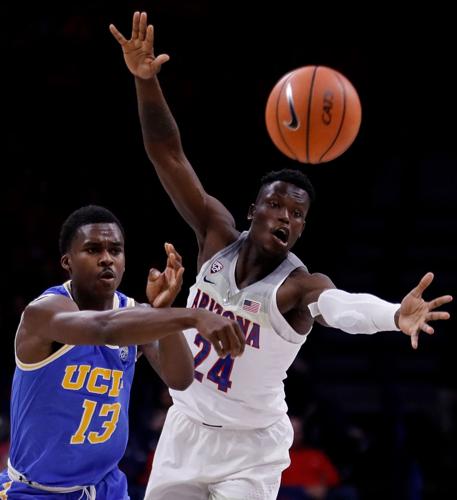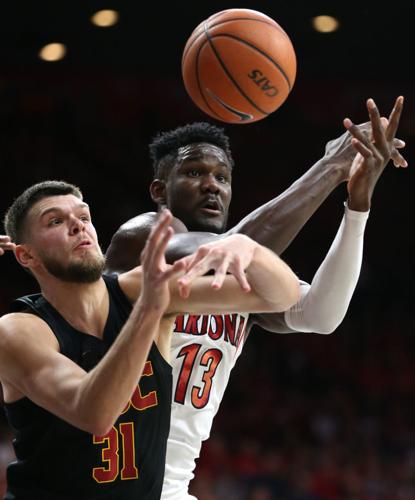SCOTTSDALE — When Pac-12 basketball coaches held spring meetings this week, all of them put on USC Trojans hats.
Not literally, of course. But they considered together how the second-place Trojans could have improved their unsuccessful effort for an NCAA Tournament bid last season.
Maybe it could have happened via an expanded 20-game schedule that brought UA and ASU to the Galen Center for some big opportunities, and/or by toughening up the Trojans’ nonconference schedule.
During meetings that mostly focused on routine matters, the conference looked at moving its traditional 18-game schedule to 20 games. It will not be voted on this week and wouldn’t be implemented until at least 2019-20, but the discussion is underway.
There are all sorts of ways the Pac-12 can get to 20 games, but for USC, a “hybrid” model might have helped the most last season because it would ensure marquee matchups are played twice each season.
Currently, all Pac-12 teams play their “geographic” rival twice, then play a randomly rotating slate of six teams twice and four teams once, to equal 18 games.
Last season, USC was among the four teams that Arizona played only once, depriving the Trojans of a chance for a homecourt win that could have kept their bubble from bursting.
Under a hybrid model that uses preseason expectations, a second game would likely have been added because UA and USC were predicted to be (and were) the league’s top two finishers.
USC finished in second place at 12-6 but did not get invited to the NCAA Tournament.
“I think it hurt USC this year not having the Arizonas on their homecourt,” Utah coach Larry Krystkowiak said.
The drawback to such a scheme is that two lesser-rated teams wouldn’t get a second crack at Arizona, potentially hurting those schools at the gate (if it were a home game for them) and in opportunity for a big win. But Krystkowiak says the overall picture of trying to get more conference teams in the tournament would take priority — and that the lesser teams most likely wouldn’t be gaining an NCAA Tournament bid from that opportunity anyway.
Gate receipts, Krystkowiak said, also aren’t a factor.
“Now I realize their fans might not be excited when they don’t have Arizona come into their building,” Krystkowiak said. “But the revenue for home crowds, if it isn’t evident already, makes no difference to anybody. This is all driven by TV, and TV is going to be really happy to know they’ve got better marquee matchups.”
UA coach Sean Miller declined to comment while Colorado coach Tad Boyle, WSU’s Ernie Kent and Washington’s Mike Hopkins all said they remained unsure about a 20-game schedule pending further study.
“I’m not sure I’m convinced one or the other is better,” Boyle said. “That’s one of the reasons I think there isn’t a consensus right now, but we’ll learn as we go.
There is a consensus on this, though: More teams in the tournament means more NCAA Tournament revenue and more prestige — for everyone.
The Pac-12 coaches are together on that one.
“We’re just trying to do what’s best for the league to raise our stature nationally and help our teams get a chance to play in the postseason,” Hopkins said. “At the end of the day you’re trying to change and adapt to our goals as a league ... so changes have to be made.”
If the conference moves to 20 games, there are plenty of logistics to wrestle with. The Pac-12’s unique geographical footprint lends itself to travel partners that are nearby and, when visitors play them, often don’t even need a flight between games.
The question is whether the league blows up the “travel partner” format to just play 20 games overall, or whether it adds the current 18-game pattern with two add-on games that would be either randomly chosen or via the “hybrid” model.
And if the Pac-12 goes for that 18-plus-2 schedule, there’s also the question of whether those extra two games happen in December or are sprinkled in during the league season.
Beyond that: There’s the issue of whether chartering to just one game makes financial sense.
“We’re looking at the travel costs, travel partners, the hybrid model and how you manage it,” Arizona AD Dave Heeke said. “Then we’ll look at it all and say, ‘How does this impact our teams’ ability to get to postseason play?’”
Nonconference scheduling can also affect teams’ ability to reach the postseason, something the Pac-12 knows all to well. Last season, USC played a soft nonconference schedule, went 12-6 in conference play (24-12 overall) — and didn’t get into the tournament.
ASU, meanwhile, beat Kansas and Xavier en route to a 12-0 nonconference record, then finished in a tie for eighth place in the Pac-12 at 8-10 — and did get in the NCAA Tournament field.
Kent and Hopkins said the Pac-12 has discussed trying to schedule as strongly as possible in nonconference play while aiming to win about 75 percent of the time. Doing so could help maximize the conference’s collective power ratings, so that all the intraconference matchups mean even more.
Of course, that’s all nice in theory. But Pac-12 teams won 69.8 percent of their nonconference games last season, only the sixth-best mark among conferences nationally, down from 72.2 percent in 2016-17 and 78.0 in 2015-16.
So no matter what the Pac-12 decides in the offseason, an improvement to that number can bring real change.
“It just gets back to winning games,” Boyle said. “That’s the bottom line.
“As a coach there’s a lot of moving targets here. It’s part scheduling, it’s part science and it’s part luck. I think all of those things come into play every year.”





